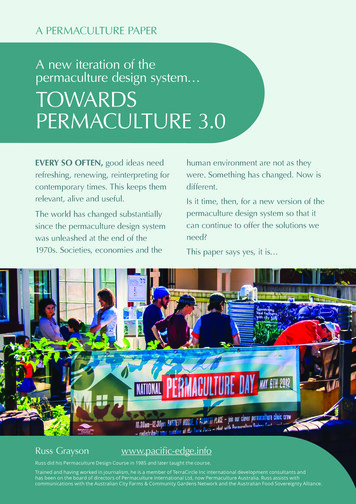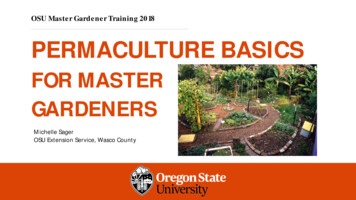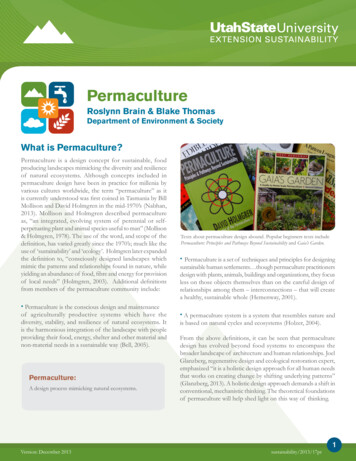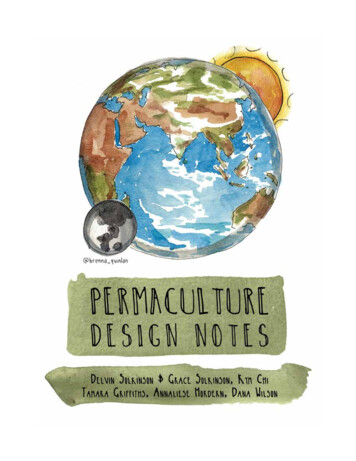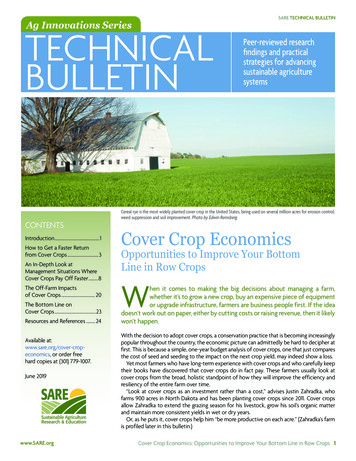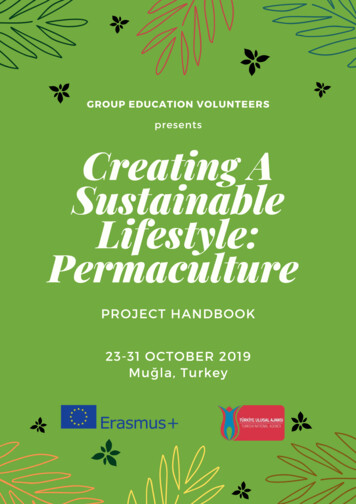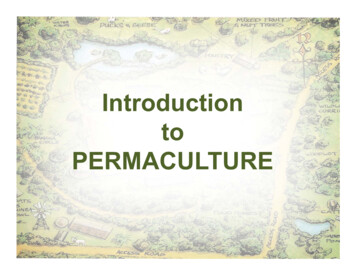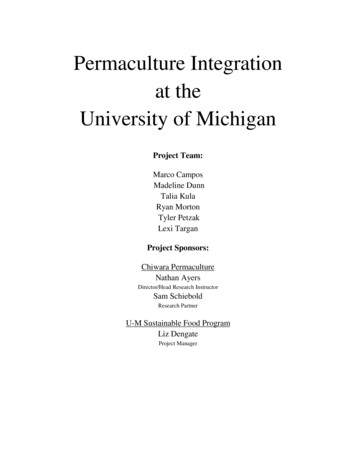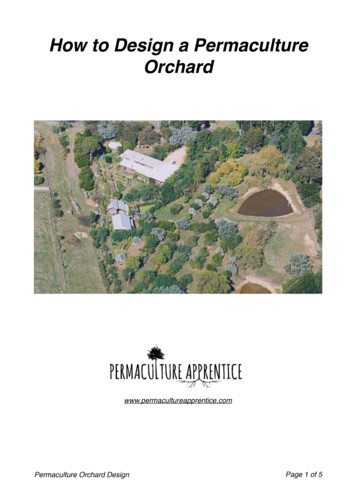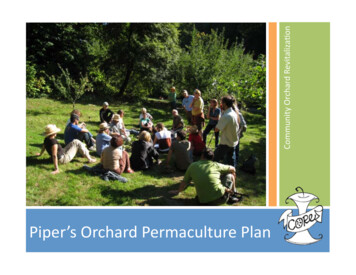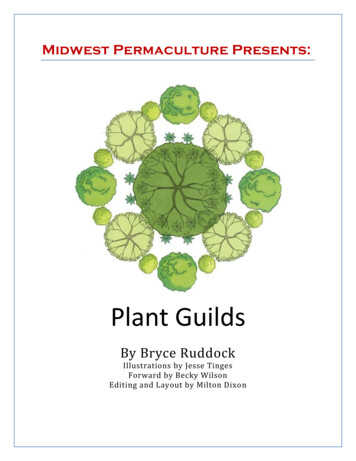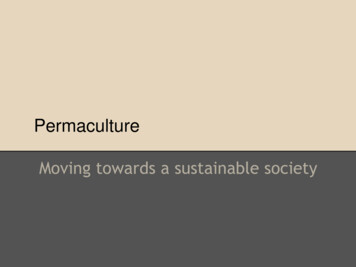
Transcription
PermacultureMoving towards a sustainable society
ObjectivesThis module is meant to simplify and provideexamples for the different aspects ofPermaculture, its ethics and principles. Itwill direct you to media from all over theweb, so think of this as a springboard tohelp you find knowledge; something betterthan just googling 'permaculture'.
TermsFunctions - work done by elements; conversion ofchemical energy, transportation of resources, energystorage, beautification, or elimination of workaltogether.Element - The cause or effect of a function. These can beorganisms, machines, buildings, tools, or landscapefeatures.Resource - any material that is regenerative or replacedin some way over time. As opposed to a source which isnot restored over timeIntensive - Something that is complex, information richand full of energy.
Some BackgroundBill Mollison and David Holmgren coined theterm "Permaculture" in the mid-1970s as acontraction of Permanent and (Agri)Culture.The philosophy arose as a direct response tothe perceived degradation of ecology,culture, and health in the last century thatresult from the extractive and controllingprocesses of industrial society.
The founders of PermacultureThey are both educators and practitioners, and the founders ofpermaculture as a movement. Each represents a portion ofpermaculture practice.- Mollison takes care of the practical side of things. His books aremore of a how-to for agricultural practice and are informative andeye-opening. Farmers focus mainly on his work. Much of thismodule was gleaned from his Introduction to Permaculture, whichis free bookintroduction-to.html.- Holmgren defines the overarching principles of permaculture. Hiswritings are more applicable to society as a whole; to consumers,business people, scientists, governments, and workers. His work ismore thought and discussion provoking.
Other Prominent Permaculturalists- Masanobu Fukuoka - Website and Free PDF of The OneStraw Revolution(his book that really started it all)- Sepp Holzer - Website , Documentary , Free PDF- Toby Hemenway - Website- Geoff Lawton - Website , he also has an abundance ofyoutube videos- Joel Salatin - Website- Patrick Whitefield - BlogMaddy Harland - Editor of Permaculture MagazineMark Shephard – Author of Restoration Agriculture-
One Definition of Permaculture- It is a method of thinking for designing any system. For some,this extends into systems of culture, belief, business,economics, and ethics.- Ideally, it is not value based, but evidence based. As in thesciences, the theories and principles are backed by testableevidence found in the natural world. Physics, chemistry,biology, math, economics, government and art all have anequal place in permaculture and vice-versa. Permaculture isabout applying information to the design of sustainablesystems.This Blog Post consolidates multiple definitions from leaders inthe field. It takes an entire book and years of experience toadequately define permaculture, so it is best to read manydefinitions as well as write your own.
The focus here is on Permaculturepractices relating to Agriculture.The philosophy of permaculture is made up of twelveguiding principles. They are elegantly outlined withexamples here. These principles were largelydeveloped and written about by David Holmgren,however they are more theoretical and harder to applydirectly to agriculture. In this unit, we will be outliningthe practical principles of permaculture designdeveloped by Bill Mollison with relevant examples inagriculture.
A quick list of Design Principles 1. Relative Location2. Each element performs many functions3. Each function is supported by many elements4. Energy Planning5. Using biological resources6. Energy Cycling7. Accelerating succession8. Value Diversity9. Design Small scale and intensive systems10. Use edge effects11. Attitude
The Chicken as modelIn the following slides, we will be discussingeach of the Design Principles, focusing on theChicken as our model element. We willdescribe each Design Principle, and thenfollow by one or more examples that integratethe Chicken element.
1. Relative LocationThis is the core of design. Each element in a system hasinputs and outputs(materials); we should locate themrelative to each other so that materials flow into oneanother. Relationships between elements arefundamental to the workings of nature, so we shouldstrive to connect the elements of our farm in a waythat forms a relationship. We want to make movingmaterials easy and sensible, allowing energy to flowalong the path of least resistance.
1. Relative LocationThe kitchen garden loopWhere canwe put ourchicken?
1. Relative LocationA worm composting setup for scraps located between thekitchen door and the vegetable garden allows nutrientsto flow easily from table to worms to soil and back totable. Our model element, the chicken, could consumeworms that have been feeding on the scraps. Theseworms can either be given as feed to the chicken at adifferent location or, if the chicken is allowed access tothe worm composting area, in scratching for worms,the chicken turns over compost & scraps, consumingsome of the scraps directly; excreting nutrients viachicken manure which add to the available worm food.This is an example of placing one element into anappropriate space between other elements for addedproducts (in this case eggs!)
2. Each Element Performs Many FunctionsEverything is multipurpose with a little information andimagination. Every aspect of an element affects how itfunctions.Our chicken has many elements and functionsassociated with it. How will we use each of these to ourbenefit?
2. Each element performs manyfunctionsThe Chicken:Forages on invasive plant seed and insects,suppressing pestsConverts its food into fertilizer and food forusCultivates the ground by searching for food
2. Each element performs manyfunctionsThis element, the areabetween the curb andsidewalk has severalfunctions: beauty,insect habitat, plantdiversity, soil buildingand forage.
3. Each Important function issupported by many elementsPests are suppressed by: chickens,allelopathic plant diversity, wildlife, healthysoil, our interventionOur food is created by: chickens, crop plants,decomposers in soil(releasing nutrients),compost biologyLand is cultivated by: our implements, ouranimals(chickens), earthworms, deep rootedplants
4. Energy PlanningEnergy planning involves taking your entireland area into account and developingdifferent Zones based on the amount oftime/work/input required to manage it. Theareas with the highest requirements arenear the house (zone 0) up to an unmanagedarea (zone 5) used for observation only. Wealso consider the natural features of theland(contour, vegetation, aspect, weatherpatterns)
4. Energy Planning
4. Energy PlanningChickens are locatedalong the dailypath, near thehouse to makecaring for themeasy and natural.This is design forsectors of land.
4. Energy PlanningWe also need toconsider slope andcontour of the landin profile. These willplay a big role inhow energy flowsnaturally. We wantto work with thisnatural flow.
5. Use Biological ResourcesAll land has resources present and a carefuleye can identify these. These come mostlyin the form of plants and microorganisms.Get a field guide and survey your land foruseful and edible things.Hedgerows are often overlooked, but highlyuseful. Chickens like to nest in this habitat.In the previous slide, we could pen thechickens in a long run on the sides instead ofusing valuable central space.
6. Energy CyclingOur food system relies on massive scale extraction ofenergy(fossil fuels, fertilizers) from the earth. It is alinear sequence of energy transfer that depletes ourresources more quickly than they can regenerate.Permaculture seeks to transfer energy in cycles thatbuild resources over time. We must seek to capture andcycle all energy coming through the land. Instead ofrelying on the manufacture and transport of chickenfeed, we seek to provide food on site by planting andencouraging diverse life. Whatever we take, we mustreturn.
6. Energy Cycling
7. Small-scale intensive systemsSmall systems require less energy to run and we can stackmore of them on a site for diverse yields. Intensivesystems rely on lots of information to get them runningefficiently, but run by themselves if properly set up.Instead of broad-scale approaches like planting 2000acres of monoculture, we begin at the area closest toour living space and develop it to a point where it isfunctioning well with minimal input. We want tomaintain control over our environment with as littleenergy as possible.
7. Small-scale, intensive systems- Sepp Holzer's Krameterhof is a great example of howmuch potential lies in small holdings.- For chickens, we wouldn’t want to start off with amassive flock even if we have done extensive research.Starting small and really getting to know them will payoff when the time is right to go into larger production
8. Accelerating successionWe understand how stable biological systemsare built over time in nature. We can mimicthis process successfully and quickly throughpermaculture design. The goal ofpermaculture is to build stable ecosystemsthat produce a yield, usually in the form ofmulti yielding food forests. This articledescribes in detail the ecological basis ofsuccession.
8. Accelerating Succession
8. Accelerating SuccessionThe chicken is best introduced in the youngforest stage, where it has perennial groundcover to brood in but also low shrubs inwhich to roost. Young forests also haveabundant insects and seed production.
9. DiversityDiversity is natural and stable. It allows change tooccur without detriment and increasesproduction over time. Plants, animals, insectsand microbes all work and compete together toform the beauty that we call nature. Knowingthe habits of a variety of organisms will allowyou to place them together in a system so thatthey complement one another. This is called aguild because the organisms create anenvironment allowing for the existence of morecomplex and abundant forms.
9. Diversity- Pastures interplanted with trees have been shown to beas productive for grazing as treeless pasture with theadded benefit of shade, fruit, nut, or fuel production.- Our chicken will do best not with a high quality bag offeed and a hut to sit in, but within a guild of bugs,plants, and microbes. It should have plenty to eat and amosaic of environments to live in. If one type of food orshelter is scarce, there are others to rely on.- Birds are an important piece of farm diversity.Everything gardens, or has an effect on itsenvironment.
9. Diversity
10. Edge EffectsEdges are the interface between two mediumswhere energy flows back and forth. Lifeexists as the effect of this flow. Diversity istherefore higher at the edge than in themiddle of an area of evenness, whereenergy is easily immobilized.The importance of edge
10. Edge effectsThis is a diagram only, but you can see thesame effect present in nature. The densityand diversity of vegetation is highest at theinterface between forest and grassland.
11. Attitudinal PrinciplesFailures are learning opportunities. The negative effects offailure are minimized if we ask the right questions and learnfrom the mistake.Experimentation gains you experience, which is necessary tofinding the best way to do things.Every site has an abundance of resources in place in the formof wind, water, rocks, weeds, and wildlife. These resourcesbecome obvious with access to the right informationCreativity is the biggest limit to the effectiveness of design.Chickens are destructive to the ground when penned indensely. If this is our only option, we can use it to ouradvantage such as clearing ground for planting by penningthem in movable structures.
ExerciseEvaluate the aspects of the following 3 siteplans.-Which one would you pick as the mosteffective?-What would you change about it?-Does the plan follow our guiding principles?
Self Review What are benefits of permaculture for the farmer? For the environment?What are the basic principles ofpermaculture?How can your farming plans include morepermaculture aspects?
Resources Books, Articles, Web Resources by Bill MollisonBooks, Articles, Web Resources by /www.permaculture.org/
Other Prominent Permaculturalists - Masanobu Fukuoka - Website and Free PDF of The One Straw Revolution(his book that really started it all) - Sepp Holzer - Website , Documentary , Free PDF - Toby Hemenway - Website - Geoff Lawton - Website , he also has an abundance of youtube videos - Joel Salatin - Website
